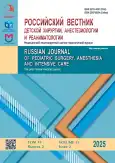儿童脾脏创伤性破裂非手术治疗中腹膜的生理特征
- 作者: Podkamenev V.V.1, Pikalo I.A.1, Akudovich N.V.1, Titov E.A.2, Mikhailov N.I.3, Sharapov I.S.3
-
隶属关系:
- Irkutsk State Medical University
- East Siberian Institutе of Medical and Ecological Research
- Ivano-Matreninskaya Children's City Clinical Hospital
- 期: 卷 15, 编号 2 (2025)
- 页面: 163-172
- 栏目: Original Study Articles
- URL: https://journal-vniispk.ru/2219-4061/article/view/312998
- DOI: https://doi.org/10.17816/psaic1910
- EDN: https://elibrary.ru/DKTLEQ
- ID: 312998
如何引用文章
全文:
详细
论证。脾脏创伤性破裂常伴有腹腔出血和血腹形成,据推测,血腹可能诱导粘连形成并导致粘连性疾病的发展。
目的:探讨血腹状态下完整腹膜的生理特性及其对粘连形成的影响。
方法。开展一项前瞻性队列研究,共纳入103例脾脏创伤性破裂患儿。其中91例(88.3%)接受了非手术治疗,并通过动态超声评估血腹的体积及其消退时间。对95例(92.2%)患儿在伤后6个月内进行随访, 38例(36.9%)随访至6个月至3年,10例(9.7%)随访超过3年。实验部分在18只Chinchilla品系兔上进行。 通过向腹腔注入12–15 ml自体血液模拟血腹模型。在1至30天内采集腹膜组织并进行组织学分析。
结果。本研究在对脾脏创伤性破裂患儿进行非手术治疗的过程中,获得了关于血腹状态下完整腹膜生理特性的新的认识。在对脾脏创伤性破裂患儿进行非手术治疗的过程中,确认了血腹可自发吸收的现象,这一发现证明无需外科干预亦可清除腹腔内积血。超声显示血腹的消退时间为7 [3; 9] 天, 且与患儿年龄无关(H = 3.18;p = 0.2)。在非手术治疗脾脏创伤性破裂患儿的过程中发现,腹膜具有此前未被描述的特性:在间皮保持完整的情况下,血腹不会导致粘连形成。这一抗粘连特性提示,在血腹状态下具备实现粘连形成初级预防的可能性。
结论:本研究在对儿童脾脏创伤性破裂进行非手术治疗的背景下,探讨了血腹状态下完整腹膜的生理特性。从生理学角度来看,完整腹膜在血腹状态下具有保护性的抗粘连和吸收特性。对接受非手术治疗的脾脏破裂患儿所开展的长期随访证实,其腹腔未发生粘连形成。
作者简介
Vladimir V. Podkamenev
Irkutsk State Medical University
Email: vpodkamenev@mail.ru
ORCID iD: 0000-0003-0885-0563
SPIN 代码: 7722-5010
MD, Dr. Sci. (Medicine), Professor
俄罗斯联邦, IrkutskIlya A. Pikalo
Irkutsk State Medical University
编辑信件的主要联系方式.
Email: pikalodoc@mail.ru
ORCID iD: 0000-0002-2494-2735
SPIN 代码: 4885-4209
MD, Dr. Sci. (Medicine)
俄罗斯联邦, IrkutskNatalya V. Akudovich
Irkutsk State Medical University
Email: meloman00@bk.ru
ORCID iD: 0000-0003-2790-6681
SPIN 代码: 7914-7038
MD, Cand. Sci. (Medicine), Associate Professor
俄罗斯联邦, IrkutskEvgeny A. Titov
East Siberian Institutе of Medical and Ecological Research
Email: G57097@yandex.ru
ORCID iD: 0000-0002-0665-8060
SPIN 代码: 7581-4258
Cand. Sci. (Biology)
俄罗斯联邦, AngarskNikolay I. Mikhailov
Ivano-Matreninskaya Children's City Clinical Hospital
Email: mni.irk@ya.ru
ORCID iD: 0000-0002-7428-3520
SPIN 代码: 1153-3175
MD, Cand. Sci. (Medicine)
俄罗斯联邦, IrkutskIvan S. Sharapov
Ivano-Matreninskaya Children's City Clinical Hospital
Email: endoirk@gmail.com
ORCID iD: 0009-0003-7516-7753
SPIN 代码: 8002-4206
俄罗斯联邦, Irkutsk
参考
- Jannatdoust P, Valizadeh P, Amoukhteh M, et al. Diagnostic performance of contrast-enhanced ultrasound in traumatic solid organ injuries in children: a systematic review and meta-analysis. Pediatr Radiol. 2025;55(2):226–241. doi: 10.1007/s00247-024-06127-9
- Olsen A, Possfelt-Møller E, Jensen LR, et al. Follow-up strategies after non-operative treatment of traumatic splenic injuries: a systematic review. Langenbecks Arch Surg. 2024;409(1):315. doi: 10.1007/s00423-024-03504
- Lavreshin PM, Gobejishvili VK, Kelasov IG, Gobejishvili BB. Profilaxis of intraabdominal adhesion in patients with mechanical abdominal trauma and hemoperitoneum. Journal of Experimental and Clinical Surgery. 2013;6(2):148–154. doi: 10.18499/2070-478X-2013-6-2-148-154 EDN: RJDPPP
- Kuzyakova LM, Skalskiy SV, Stepanova EF, et al. Influence of blockers of slow calcium channels on the processes of proliferation and collagenogenesis of fibroblasts in the formation of spices in the abdominal cavity. Medical News of North Caucasus. 2019;14(1-2):208–211. doi: 10.14300/mnnc.2019.14016 EDN: SCADXR
- Pikalo IA, Podkamenev VV, Titov EA. Influence of hemoperitoneum in spleen injury on the formation of peritoneal adhesions in intact peritoneum. Kazan medical journal. 2022;103(5):870–878. doi: 10.17816/KMJ2022-870 EDN: XWZCLO
- Gill S, Hoff J, Mila A, et al. Post-traumatic splenic injury outcomes for nonoperative and operative management: A systematic review. World J Surg. 2021;45(7):2027–2036. doi: 10.1007/s00268-021-06063-x
- Ignat’ev VV, Oleynik AV, Muraviev AV, et al. Treatment of children with blunt spleen injury throughout 25-year period in Sevastopol and the Republic of Crimea. Pirogov Russian Journal of Surgery. 2025;(2):67-76. doi: 10.17116/hirurgia202502167 EDN: FJJJPL
- Williams RF, Grewal H, Jamshidi R, et al. Updated APSA guidelines for the management of blunt liver and spleen injuries. J Pediatr Surg. 2023;58(8):1411–1418. doi: 10.1016/j.jpedsurg.2023.03.012
- Patent RU No. 2830196 C1/ 14.11.2024. Pikalo IA, Podkamenev VV, Mikhailov NI, et al. Method for determining the volume of free fluid in the abdominal cavity. (In Russ.)
- Samokhvalov IM, Suvorov VV, Myasnikov NI, et al. Hemoperitoneum in nonoperative management of blunt splenic injury: two reasons to put the scalpelaside. Medical newsletter of Vyatka. 2023;(2):43–50. doi: 10.24412/2220-7880-2023-2-43-50 EDN: WRMIDG
- Minaev SV, Timofeev SI, Grigorova AN, et al. Specific features of the adhesion process of the abdominal cavity in children with different degrees of connective tissue dysplasia. Russian Journal of Pediatric Surgery, Anesthesia and Intensive Care. 2020;10(4):381–389. doi: 10.17816/psaic705 EDN: HDEEUK
- Jackson-Jones LH, Smith P, Portman JR, et al. Stromal cells covering omental fat-associated lymphoid clusters trigger formation of neutrophil aggregates to capture peritoneal contaminants. Immunity. 2020;52(4):700–715.e6. doi: 10.1016/j.immuni.2020.03.011
- Strippoli R, Sandoval P, Moreno-Vicente R, et al. Caveolin1 and YAP drive mechanically induced mesothelial to mesenchymal transition and fibrosis. Cell Death Dis. 2020;11(8):647. doi: 10.1038/s41419-020-02822-1
补充文件














